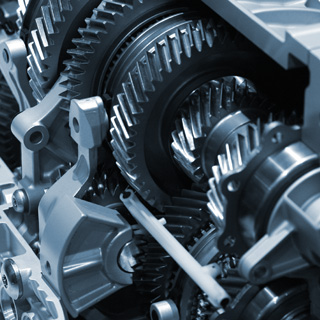 Gears
Gears
The rolling and sliding actions
which occur in all types of gearing, such as spur, helical,
worm, spiral bevel or hypoid, present a different type of
challenge to lubricants compared to ball or roller bearings.
Many designers, especially worm gear designers, are
interested in increasing gear box efficiency.  Modern
designs require the most in power transfer with minimal
noise and heat generation. In some cases, oils are being
replaced by specially designed synthetic greases to reduce
component cost by eliminating the need for seals and the
machining costs associated with oil seal designs. Other gear
train designs may have special operating environments
including high and low temperature, corrosion and oxidation
concerns.
Modern
designs require the most in power transfer with minimal
noise and heat generation. In some cases, oils are being
replaced by specially designed synthetic greases to reduce
component cost by eliminating the need for seals and the
machining costs associated with oil seal designs. Other gear
train designs may have special operating environments
including high and low temperature, corrosion and oxidation
concerns.
With modern lubricants, these challenges can be met very
effectively. Utilizing various synthetic base oils and
gellants these lubricants not only minimize friction but can
inhibit wear and corrosion, dampen noise and control free
motion. They can meet broad temperature requirements without
oxidizing or evaporating. And they can provide manufacturers
of today’s power transmission devices with an “edge” that
will increase the performance and life of their products.
Synthetic vs. petroleum-based lubricants.
In theory, the “perfect
lubricant” won’t oxidize, suffer thermal breakdown,
evaporate or allow surface contact for the life of the
device. Generally ambient temperature range plays a major
role in determining whether to use a synthetic or
petroleum-based lubricant. Synthetics tend to function
better at wider temperature ranges than petroleum products.
Petroleum products begin to degrade at or before 100°C,
whereas synthetic hydrocarbon lubricants function well to
125°C. By comparison, UniFlor™ fluoroether
lubricants provide excellent lubricating qualities to 250°C.
Synthetics offer extreme low temperature advantages as well.
Synthetic lubricants have lower vapor pressures than
petroleum products, consequently, even without the presence
of oxygen, synthetics are less volatile, an important factor
in ensuring that the lubricant does not breakdown. In
summary, the chemical homogeneity of synthetic lubricants
results in greater load carrying capacity, higher viscosity
indexes, better lubricity, greater efficiency and extended
serviceability than their petroleum-based counterparts.
Our Products
A partial list of the most commonly used Nye synthetic lubricants for gear applications.
|
General Purpose Gear Greases |
Base Oil Chemistry |
Temperature Range (°C) |
ISO Viscosity Grade |
Base Oil Viscosity @ 40°C |
NLGI Grade |
Dropping Point (°C) |
Consistency |
|---|---|---|---|---|---|---|---|
| INSTRUMENT GREASE 794A | PAO/Ester | -20 to 150 | 460 | 440 | 2 | 260 | Medium |
| NYOGEL 788 | PAO/Polybutene | -20 to 125 | 460 | 291 | 1 | Over 350 | Medium/Soft |
| NYOGEL 792D | PAO | -30 to 125 | 150 | 182 | 260 | Semi-fluid | |
| RHEOLUBE 363AX-1 | PAO | -50 to 125 | 46 | 40.7 | 2 | 220 | Medium |
| RHEOLUBE 368AX-1 | PAO | -20 to 125 | 220 | 259 | 2 | 255 | Medium |
| RHEOLUBE 368SM | PAO | -40 to 120 | 220 | 243 | 0.5 | 200 | Very Soft |
| RHEOLUBE 377AL | PAO | -40 to 125 | 46 | 45 | 1 | 194 | Soft |
| RHEOLUBE 380 | PAO/Ester | -50 to 130 | 32 | 33.6 | 2 | 194 | Medium |
| RHEOLUBE 380-G1 | PAO/Ester | -50 to 130 | 32 | 37 | 1 | 190 | Soft |
| RHEOLUBE 723GR | PAO | -40 to 125 | 68 | 80.6 | 0.5 | 205 | Very Soft |
|
High Temperature Gear Greases |
Base Oil Chemistry |
Temperature Range (°C) |
ISO Viscosity Grade | Base Oil Viscosity @ 40°C | NLGI Grade | Dropping Point (°C) | Consistency |
|---|---|---|---|---|---|---|---|
| UNIFLOR 8511 | PFPE | -50 to 225 | 68 | 65 | 2 | Non-melting | Medium |
| UNIFLOR 8531 | PFPE | -40 to 225 | 220 | 230 | 2 | Non-melting | Medium |
|
Flea-Power Gear Grease |
Base Oil Chemistry |
Temperature (°C) |
ISO Viscosity Grade | Base oil Viscosity @ 40°C | NLGI Grade | Dropping Point (°C) | Consistency |
|---|---|---|---|---|---|---|---|
| NYOGEL 741E | Phenylmethyl Silicone | -50 to 200 | 150 | 151 | 000 | 223 | Semi-fluid |
|
Food Grade Gear Grease |
Base Oil Chemistry |
Temperature (°C) |
ISO Viscosity Grade | Base oil Viscosity @ 40°C | NLGI Grade | Dropping Point (°C) | Consistency |
|---|---|---|---|---|---|---|---|
| FLUOROCARBON GEL 800 | Ester | -35 to 150 | 100 | 104.5 | 2 | 300 | Medium |
| FLUOROCARBON GEL 800GR-1 | Ester | -35 to 150 | 100 | 104.5 | 1 | 306 | Soft |
| UNIFLOR 8931 | PFPE | -70 to 250 | 320 | 310 | 2 | Non-melting | Medium |
| NYOGEL 670F | PAO | -35 to 120 | 220 | 194 |